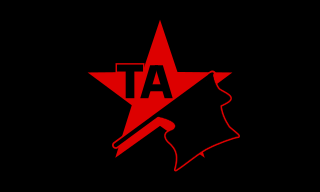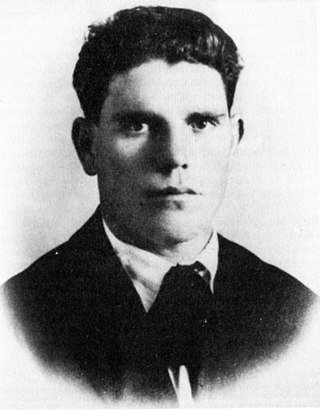Related Research Articles
Anarchist communism is a political philosophy and anarchist school of thought that advocates communism. It calls for the abolition of private property but retention of personal property and collectively-owned items, goods, and services. It supports social ownership of property and the distribution of resources "From each according to his ability, to each according to his needs".

Errico Malatesta was an Italian anarchist propagandist and revolutionary socialist. He edited several radical newspapers and spent much of his life exiled and imprisoned, having been jailed and expelled from Italy, Britain, France, and Switzerland. Originally a supporter of insurrectionary propaganda by deed, Malatesta later advocated for syndicalism. His exiles included five years in Europe and 12 years in Argentina. Malatesta participated in actions including an 1895 Spanish revolt and a Belgian general strike. He toured the United States, giving lectures and founding the influential anarchist journal La Questione Sociale. After World War I, he returned to Italy where his Umanità Nova had some popularity before its closure under the rise of Mussolini.
Anarchism and violence have been linked together by events in anarchist history such as violent revolution, terrorism, assassination attempts and propaganda of the deed. Propaganda of the deed, or attentát, was espoused by leading anarchists in the late 19th century and was associated with a number of incidents of political violence. Anarchist thought, however, is quite diverse on the question of violence. Where some anarchists have opposed coercive means on the basis of coherence, others have supported acts of violent revolution as a path toward anarchy. Anarcho-pacifism is a school of thought within anarchism which rejects all violence.

Carlo Cafiero was an Italian anarchist, champion of Mikhail Bakunin during the second half of the 19th century and one of the main proponents of anarcho-communism and insurrectionary anarchism during the First International.

The Biennio Rosso was a two-year period, between 1919 and 1920, of intense social conflict in Italy, following the First World War. The revolutionary period was followed by the violent reaction of the fascist blackshirts militia and eventually by the March on Rome of Benito Mussolini in 1922.

Camillo Berneri was an Italian professor of philosophy, anarchist militant, propagandist and theorist. He was assassinated during the Spanish Civil War, presumably on the orders from Stalin's USSR.

Umanità Nova is an Italian anarchist newspaper founded in 1920.
Italian anarchism as a movement began primarily from the influence of Mikhail Bakunin, Giuseppe Fanelli, and Errico Malatesta. Rooted in collectivist anarchism and social anarchism, it expanded to include illegalist individualist anarchism, mutualism, anarcho-syndicalism, and especially anarcho-communism. In fact, anarcho-communism first fully formed into its modern strain within the Italian section of the First International. Italian anarchism and anarchists participated in the biennio rosso and survived Italian Fascism. Platformism and insurrectionary anarchism were particularly common in Italian anarchism and continue to influence the movement today. The synthesist Italian Anarchist Federation appeared after the war, and autonomismo and operaismo especially influenced Italian anarchism in the second half of the 20th century.

The Arditi del Popolo was an Italian militant anti-fascist group founded at the end of June 1921 to resist the rise of Benito Mussolini's National Fascist Party and the violence of the Blackshirts (squadristi) paramilitaries. It grouped revolutionary trade-unionists, socialists, communists, anarchists, republicans, anti-capitalists, as well as some former military officers, and was co-founded by Giuseppe Mingrino, Argo Secondari and Gino Lucetti – who tried to assassinate Mussolini on 11 September 1926 – the deputy Guido Picelli and others. The Arditi del Popolo were an offshoot of the Arditi elite troops, who had previously occupied Fiume in 1919 behind the poet Gabriele d'Annunzio, who proclaimed the Italian Regency of Carnaro. Those who split to form the Arditi del Popolo were close to the anarchist Argo Secondari and were supported by Mario Carli. The formazioni di difesa proletaria later merged with them. The Arditi del Popolo gathered approximately 20,000 members in summer 1921.
The International Anarchist Congress of Amsterdam took place from 24 August to 31 August 1907. It gathered delegates from 14 countries, among which important figures of the anarchist movement, including Errico Malatesta, Luigi Fabbri, Benoît Broutchoux, Pierre Monatte, Amédée Dunois, Emma Goldman, Rudolf Rocker, Christiaan Cornelissen, et al.

The Italian Anarchist Federation is an Italian anarchist federation of autonomous anarchist groups all over Italy. The Italian Anarchist Federation was founded in 1945 in Carrara. It adopted an "Associative Pact" and the "Anarchist Program" of Errico Malatesta. It decided to publish the weekly Umanità Nova, retaking the name of the journal published by Errico Malatesta.
Giovanni Defendi was an Italian revolutionary who fought for the Paris Commune, was imprisoned, and after release spent many years as a grocer and anarchist leader in exile in London.
Carl Levy is professor of politics at Goldsmiths College, University of London. He is a specialist in the history of modern Italy and the theory and history of anarchism.

Pio Turroni was an Italian anarchist and editor of many anarchist publications. He fought for the Republican side in the Spanish Civil War as a member of the Confederal Militias.

Anarchist Struggle is an anarchist auxiliary military unit, composed mainly of international volunteers, that is involved in the Rojava conflict of the Syrian Civil War. It was founded in 2017 and later integrated into the International Freedom Battalion.
The Capolago congress, a meeting to establish an Italian anarchist federation, was held in Capolago, Switzerland, from January 4–6, 1891.

Ugo Mazzucchelli was an Italian anarchist, anti-fascist and wartime partisan leader. He is best remembered as the commander of the Lucetti Battalion which became known as a tough opponent for the German and Fascist forces, when Italy became a critical battleground between 1943 and 1945, following the arrest of Mussolini.

Paolo Lega (1868–1896), also known as Marat, was an Italian anarchist who attempted to assassinate the prime minister, Francesco Crispi.
Gino Bibbi was an Italian engineer, political activist, anarchist, militant antifascist who participated in the Spanish Revolution of 1936 as a republican fighter pilot. Earlier, he had placed his engineering skills at the service of the causes for which he fought. He supplied the SIPE grenade-bomb which his cousin Gino Lucetti threw at Mussolini's car in Rome on 11 September 1926. The bomb exploded only after bouncing off the roof of the car containing its intended target: Mussolini was undamaged. Bibbi was arrested, but later escaped and fled abroad.
The anarchist brigades of the Italian Resistance were active during the Second World War, especially in central and northern Italy.
References
- ↑ Dadà 1984, p. 3.
- 1 2 La Torre 2006.
- ↑ Masini 1981, p. 67.
- ↑ Berti 2003, pp. 607–615.
- ↑ Schirone 2010, pp. 17–35.
- ↑ Berti 2003, pp. 616–632.
- ↑ Berti 2003, pp. 681–693.
- ↑ Schirone 2010, pp. 60–62.
- ↑ Berti 2003, pp. 721–731.
- ↑ Schirone 2010, pp. 149–159.
- ↑ Berti 2003, p. 734.
- ↑ De Agostini & Schirone 2015, pp. 17–22.
- ↑ De Agostini & Schirone 2015.